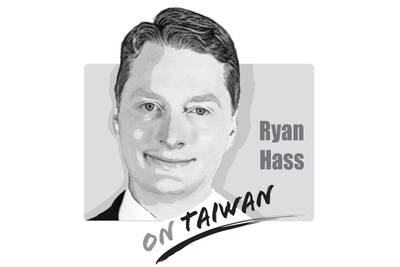The situation in China’s Xinjiang Uighur Autonomous Region is rapidly deteriorating. Multiple reports on the ground in addition to analysis of satellite imagery and open-source data paint a bleak picture of repression and forced internment in the isolated region.
On this side of the Taiwan Strait, anyone who still believes that unification with China is a viable option should sit up and take note.
An analysis of government documents by German academic Adrian Zenz and a special investigation by the BBC has revealed the sinister reality of a rapidly expanding network of “vocational education and training centers” in Xinjiang.
Tender documents show that the centers’ construction is replete with razor wire and watchtowers. Documents also reveal that staff in some centers are armed with a plethora of weapons and restraining devices, such as electric cattle prods, tear gas, stun guns, Tasers and spiked clubs known as “wolf’s teeth.”
At least one center requested the purchase of “tiger chairs,” a device used by Chinese police to torture interrogation subjects.
There are estimated to be at least 181 re-education facilities in Xinjiang, which Zenz believes could be holding as many as 1 million ethnic Uighurs and other Muslim minorities.
Beijing initially denied their existence, but now claims that enrollment is entirely voluntary and has released propaganda videos in an attempt to spin the centers as vocational schools for grateful students to brush up on their Mandarin and try knitting or baking.
In reality, an ethnic and religious minority is being interned: 20th-century history shows that this will not end well.
Radio Free Asia reported that in Haniqatam, up to 6,000 villagers have been indefinitely detained in centers; the initial batch of inmates has been incarcerated for two years.
Arbitrary quotas appear to be in effect and local sources have said that as many as 40 percent of residents in each village are being rounded up.
“In some houses the husband has been taken away, while in others the wife has been taken away and others still have had both detained, leaving the children behind,” said a local police officer who wished to remain anonymous.
It is becoming ever more apparent that under Chinese President Xi Jinping (習近平), China is fast regressing to its authoritarian past and the dark days of Mao Zedong’s (毛澤東) Cultural Revolution.
An Agence France-Presse report quotes Xinjiang Party Secretary Chen Quanguo (陳全國) as saying: “To build new, better Chinese citizens, the centers must first break their lineage, break their roots, break their connections and break their origins.”
The Chinese Communist Party of course has experience in this field. It invaded and conquered Tibet in the early 1950s and since then, it has systematically worked to destroy Tibetan culture and displace Tibetans with Han Chinese.
By contrast, Hong Kong was “peacefully reunited with the motherland” in 1997, yet the methods and end result are the same — the importation of mainland Chinese to dilute the local population and the gradual hollowing out of Hong Kong’s independent judiciary, media and its mini-constitution.
The evidence could not be clearer. Whether conquered by force or through a peaceful accommodation with Beijing, Taiwan’s freedoms would be gradually and systematically snuffed out.
Like the hapless residents of Xinjiang, Tibet and Hong Kong, Taiwan would be left a shell of its former self and an impotent outpost of China’s colonial empire.

There has been much catastrophizing in Taiwan recently about America becoming more unreliable as a bulwark against Chinese pressure. Some of this has been sparked by debates in Washington about whether the United States should defend Taiwan in event of conflict. There also were understandable anxieties about whether President Trump would sacrifice Taiwan’s interests for a trade deal when he sat down with President Xi (習近平) in late October. On top of that, Taiwan’s opposition political leaders have sought to score political points by attacking the Lai (賴清德) administration for mishandling relations with the United States. Part of this budding anxiety
The diplomatic dispute between China and Japan over Japanese Prime Minister Sanae Takaichi’s comments in the Japanese Diet continues to escalate. In a letter to UN Secretary-General Antonio Guterres, China’s UN Ambassador Fu Cong (傅聰) wrote that, “if Japan dares to attempt an armed intervention in the cross-Strait situation, it would be an act of aggression.” There was no indication that Fu was aware of the irony implicit in the complaint. Until this point, Beijing had limited its remonstrations to diplomatic summonses and weaponization of economic levers, such as banning Japanese seafood imports, discouraging Chinese from traveling to Japan or issuing
On Nov. 8, newly elected Chinese Nationalist Party (KMT) Chairwoman Cheng Li-wun (鄭麗文) and Vice Chairman Chi Lin-len (季麟連) attended a memorial for White Terror era victims, during which convicted Chinese Communist Party (CCP) spies such as Wu Shi (吳石) were also honored. Cheng’s participation in the ceremony, which she said was part of her efforts to promote cross-strait reconciliation, has trapped herself and her party into the KMT’s dark past, and risks putting the party back on its old disastrous road. Wu, a lieutenant general who was the Ministry of National Defense’s deputy chief of the general staff, was recruited
The Food and Drug Administration (FDA) on Nov. 5 recalled more than 150,000 eggs found to contain three times the legal limit of the pesticide metabolite fipronil-sulfone. Nearly half of the 1,169 affected egg cartons, which had been distributed across 10 districts, had already been sold. Using the new traceability system, officials quickly urged the public to avoid consuming eggs with the traceability code “I47045,” while the remainder were successfully recalled. Changhua County’s Wenya Farm — the source of the tainted eggs — was fined NT$120,000, and the Ministry of Agriculture instructed the county’s Animal Disease Control Center to require that